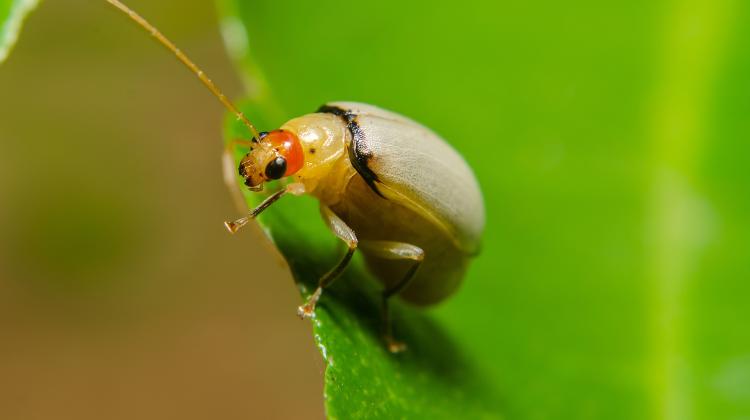Wing-cases responsible for great evolutionary success of beetles
 Credit: Adobe Stock
Credit: Adobe Stock
Beetles' wing-cases (elytra) are one of the most important adaptation achievements of this group of insects, which ensured its enormous evolutionary success. A research team including a Polish scientist published an extensive analysis of the evolution, modification and various functions of these structures in Biology Letters.
'Recently, together with Professor Rolf Beutel, one of the most eminent specialists in the field of insect evolution, we have published a paper on the evolution, modification and biological functions of beetles' elytra,’ says Dr. Jakub Goczał from the Department of Forest Ecosystems Protection of the University of Agriculture in Kraków. 'The development of elytra is considered a key evolutionary innovation contributing to the unprecedented evolutionary success of beetles - a group that now accounts for almost a quarter of animal species known to science. In addition to the history of this structure, we discussed the unusual functions it can perform.'
Elytra can be used to recover water from mist, extend the penis, communicate with sound, dive or transfer symbiotic microorganisms.
MILLIONS OF YEARS OLD
Elytra, wing-cases or hardened forewings are paired structures resulting from the transformation of the first pair of insect wings. They are clearly hardened, because their primary role is to protect the body and the second, membranous pair of wings used for flying.
In their latest publication, Dr. Goczał and Professor Rolf Beutel say that the formation of elytra was a groundbreaking morphological adaptation that contributed to the incredible evolutionary success of beetles. Despite this, knowledge about the functional aspects of these structures is still incomplete, even fragmentary, and dispersed over a large number of studies.
'Here, we have synthesized the presently available information on the evolution, development, modifications and biological functions of this crucial evolutionary novelty,’ the authors say. They add that elytra probably formed in the Carboniferous as a result of the gradual process of progressive forewing sclerotization. This was achieved through the co-option of genes regulating increased cuticle hardening of other body parts and their integration into the wing gene network. The sequential pressure that led to this transformation was probably the exploration of new microhabitats by the ancestors of modern beetles, in particular the narrow spaces under the bark of arborescent plants. By colonizing a new ecological niche, beetles gained a stable, high-humidity environment with less pressure from predators and less competition for resources.
THOUSANDS OF FORM
Over millions of years, this structure underwent further morphological changes and in many lineages of modern beetles no longer resembles the 'original'. Although in the vast majority of these insects, the elytra are very well developed and fully cover the abdomen, in some they can be fused together, sometimes richly carved (including spines) or unusually coloured, covered with bristles, and often also reduced (partially or even completely) .
All these modifications have their evolutionary justification. For example, the advantage of fusion of the elytra is to minimise water loss and/or achieve better mechanical protection needed to survive contact with some predators. The authors recall recent research on exceptionally durable, almost indestructible beetles from the family Zopherinae, which, thanks to the extraordinary design of interlocking sutures, are able to withstand extreme loads (e.g. a car driving over their body).
MULTITUDE OF FUNCTIONS
Although the primary function of the elytra is to mechanically protect the second pair of wings and the entire body, the researchers' analysis reveals that they actually perform many important functions. 'It appears likely that the potential of the elytra to take over multiple tasks has contributed significantly to the unparalleled diversification of beetles,’ the researchers say.
The primary function is, of course, protection. Studies have shown that individuals with the elytra removed experience much more damage to the webbed wings during predator attacks, and their mortality is much higher. They are also more susceptible to injury due to falls from great heights.
Various external structures (e.g. spines, tubercles, denticles) that may appear on the surface of the elytra play an important role in anti-predation strategies. The formation of distinct dorsal spines in some leaf beetles may be a response to pressure from some predators (e.g. amphibians), and specifically shaped denticles on the elytral declivity of bark beetles may be protective structures used in burrow-blocking against predators.
Sometimes, as in the case of beetles of the subfamily Paussinae, the elytra form a characteristic flange used for well-aimed spraying of defensive substances.
The researchers say: ‘It is noteworthy that the mechanical protective function is significantly reduced or even absent in some groups.’ They add that various alternative defence strategies have been identified in groups of beetles, including chemical protection, mimicry, hardening of the abdominal tergites or aposematic coloration.
The coloration of the elytra is one of the most important defence strategies. Orange and black, contrasting patterns protect, for example, individuals from the Silphidae family from birds, just like the spotted elytra of ladybirds that suggest to predators that these insects are poisonous or unpleasant in taste.
In addition, the appearance of the elytra can aid in camouflage - thanks to the unique combination of elytral indentations, crests and tubercles, the insect can, for example, look like a piece of bark, and thanks to the rough, hairy surface of the elytra, it can even cultivate an epizootic moss garden on its body, providing excellent camouflage.
The elytra also have a thermoregulatory function: they absorb part of the radiation to increase body temperature or - alternatively - reflect it to prevent overheating. They also effectively protect against water loss from the body.
Another very unusual function is related to water - in species of the darkling beetles inhabiting the Namib Desert in southwest Africa, specialized elytra capture water from fog. Standing on the dune ridges in a characteristic posture, the insects obtain water through increased fog condensation on hydrophilic peaks of elytral tubercles, which are surrounded by hydrophobic areas.
The elytra also help with flying. Although they do not serve this purpose directly, they stabilize the gliding individual and increase the lifting force.
Thanks to the elytra, beetles also managed to conquer the aquatic environment: they enable swimming, steering, and even 'store' a supply of air for breathing under water. The anti-adhesive properties of the elytral surfaces of some beetles help not only to burrow into the soil or faeces in which they live, but also to keep burrows clean by removing faeces and detritus using the declivity as a shovel.
The elytra enable beetles to transport symbiotic organisms (e.g. fungi). They also play an auxiliary role during copulation - for example, some beetles use the tips of the elytra to hold the female during copulation, which facilitates fertilization. There are species that use the elytra to make mating calls, or for a kind of mating dance that involves rubbing or stroking the female's elytra, or even drumming on their surface.
One of the functions of the elytra is also inter- and intra-species communication. Rubbing them with other parts of the body produces species-specific sounds.
It is clear that beetle elytra are extremely multifunctional and nearly perfect biological structures. They contributed to their extraordinary evolutionary success - after all, one in four species known to science belongs to this group of animals. What's more, the analysis of the biological functions and morphology of the elytra can contribute to a number of practical discoveries, e.g. in the field of new ultra-light materials with high strength, hydrophobic and bacteriostatic surfaces, reducing the friction of materials in media such as soil, water or air, or effective water extraction from the air in very dry areas.
PAP - Science in Poland, Katarzyna Czechowicz
kap/ agt/
tr. RL
Przed dodaniem komentarza prosimy o zapoznanie z Regulaminem forum serwisu Nauka w Polsce.


















